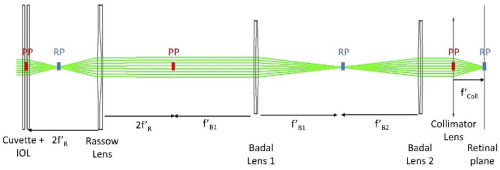Optical and visual quality of real intraocular lenses physically projected on the patient’s eye

In this new system, the real intraocular lens to be evaluated is immersed in a tray and the image seen through this lens is projected onto the patient’s eye by means of an optical system consisting of a Rassow telescope and a Badal system, which compensates the power of the intraocular lens in a range of 20 ± 5D.

One difference of this system with programmable simulators is that with this type of simulation it is necessary to have the real lenses and the simulators allow you to test the lenses even before they are manufactured.
What are intraocular lens simulators?
Visual simulators aim to assess vision with ophthalmic corrections prior to the prescription or implantation of intraocular lenses (IOLs) in the patient’s eye.
In their previous work, the scientific team compared the focus quality of these lenses before (with the simulator) and postoperatively in patients who had undergone surgery with implanted intraocular lenses and found a high correspondence between the simulation and the real implanted lens. One drawback of this study is that the validation between the simulated and real lenses could only be performed with the lens that was implanted.
However, the new tray intraocular lens projection system makes it possible to confirm the data obtained from the simulator with multiple lenses, making the system a potential “gold standard” for other simulators, most of the time programmable.
Cataracts and presbyopia
Two main physiological changes affect vision as the eye ages: cataracts and presbyopia. A cataract is a clouding of the lens. The usual treatment of cataracts involves the replacement of the natural lens of the eye with an artificial intraocular lens. The other age-related condition, which appears earlier than cataracts, is presbyopia, the loss of accommodation capacity in the lens (it cannot be focused closely). Although cataract surgery aims to restore transparency in the lens, an IOL can also be implanted to correct other defects in the patient’s vision.
So, in addition to being able to correct distance vision, multifocal IOLs can also be implanted to correct presbyopia. The number of multifocal intraocular lens designs has grown rapidly in recent years.
However, it is difficult for surgeons to manage patient expectations as it is difficult to imagine what it will look like with different types of corrections. Visual simulators allow patients to experience multifocal vision with different lens designs before surgery.




